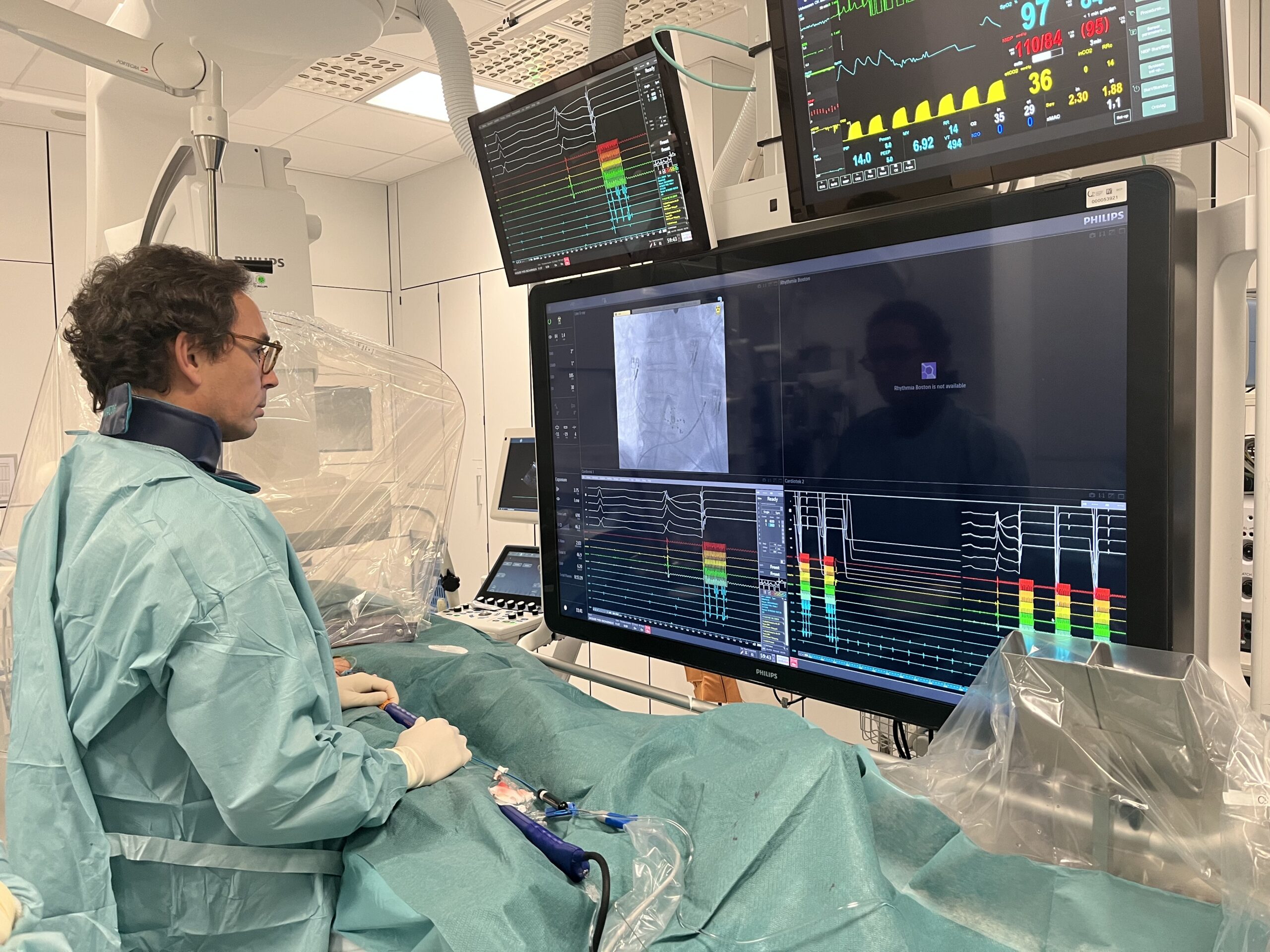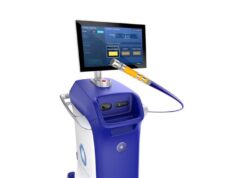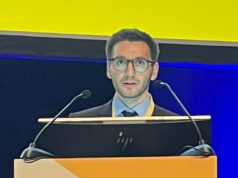This advertorial is sponsored by Boston Scientific

The arrival of pulsed-field ablation (PFA) has been heralded by many experts in the field of arrhythmia management as the most significant advance in the treatment of atrial fibrillation (AF) to have emerged in recent years.
Gian-Battista Chierchia, Gezim Bala and the team at the UZ Brussels (Brussels, Belgium) have been among the early adopters of the technology, and recently performed their 1,000th case using Boston Scientific’s FARAPULSE system. Electrophysiologists who have adopted PFA into their practice have now moved “well beyond” the initial phase of excitement over its potential advantages and are looking towards wider usage in day-to-day practice, Chierchia tells Cardiac Rhythm News, outlining the impact that the technology has had on the team’s workflow, fresh from performing the milestone ablation procedure.
FARAPULSE and other PFA systems represent an advance from other currently available ablation systems by using non-thermal pulses which create a controlled electric field to ablate and scar cardiac tissue through a process called irreversible electroporation (IRE). As there is no heating or freezing needed to ablate the targeted heart tissue, as is the case with existing technologies such as radiofrequency or cryoablation, this may reduce the potential for collateral damage to the surrounding tissues, such as the oesophagus or phrenic nerve.
Chierchia tells Cardiac Rhythm News that his experience with the FARAPULSE system began shortly after the first generation of the device became available in Europe in 2021. “The learning curve was extremely fast,” says Chierchia of his initial impression of carrying out ablation procedures with the device.
“It is remarkable that the learning curve is very short, especially for users who have experience with single-shot technologies,” adds Bala, who says that he believes the ease and convenience of the technology is based on the unique shape of the catheter—which can be used in either a ‘basket’ or ‘flower’ configuration for covering both the ostium and antrum of the vein.
The potential advancement in safety was the first perceived advantage that caught the attention of the UZ Brussels team and encouraged them to begin using FARAPULSE in their clinic. “First and foremost, it is the fact that it is a selective energy source that does not create any lesions to neighbouring structures such as the oesophagus or the phrenic nerve. The fact of it being so selective made it extremely safe for us and for our patients,” says Chierchia.
“PFA has this huge advantage of patients feeling good the next day after ablation; they don’t have these burning or oppressive sensations in their chest. Not only is it safe for us to use around the pulmonary veins, but it is also extremely comfortable for the patients.”
“We are very satisfied with the clinical results, maintaining a high success rate,” adds Bala. “It is impressive the fact that all the patients I’ve seen one day post ablation, almost none of them have any symptoms of pain. The patients seem to recover faster and do not complain about thoracic pain, comparing with radiofrequency and cryoablation technologies.”

Like any new therapy to enter practice, accumulating sufficient data to demonstrate the safety and efficacy of the therapy compared to established modes of treatment will be vital to ensuring its safe and effective adoption into real-world practice. The evidence for the FARAPULSE system continues to mount and in the last 12 months there have been a series of new findings released that underscore the promise of the technology.
Most noteworthy among these is the ADVENT trial, the multicentre randomised trial comparing the safety and efficacy of FARAPULSE to thermal ablation among patients with paroxysmal AF, previously treated with at least one anti-arrhythmic drug. Results at 12 months, shared at the 2023 European Society of Cardiology (ESC) congress (25–28 August, Amsterdam, The Netherlands), showed non-inferiority of FARAPULSE to the established ablation technologies in terms of both safety and efficacy.
On safety, ADVENT investigators note that the trial’s primary safety endpoint, a composite of serious adverse events related to use of an ablation catheter or the procedure itself and occurring within seven days, as well as pulmonary vein stenosis or oesophageal fistula occurring at any time during the 12-month follow up, occurred in just 2.1% of patients.
These safety findings are further underlined by findings of the MANIFEST 17k registry, a real-world dataset of patients treated commercially using the device at more than 106 centres throughout Europe. Results of the study, reported in late 2023, showed that among 17,068 PFA patients, there were no reported oesophageal adverse events, no pulmonary vein stenosis or persistent phrenic palsy.
The ADVENT trial also reported favourable outcomes in terms of efficacy, with a 73.3% success rate in the study’s primary efficacy endpoint, a composite of one-year freedom from recurrent atrial arrhythmias, antiarrhythmic drug use, and cardioversion or repeat ablation.
Considering whether these results mirror his experience in real-world practice, Chierchia comments that the results his team has observed could even exceed those seen in the setting of the trial. “We have a higher success rate than what is reported”, Chierchia comments, attributing this to having learned from early clinical trial experience and adopting optimised delivery protocols in their practice.
“We have started with the optimised biphasic PFA protocol, using eight-pulse PFA deliveries per vein. The early trials had to include patients that were treated with previous protocols which have been shown as being less effective than what we have today,” Chierchia explains, adding that the experience of the UZ Brussels team in using single-shot devices has largely influenced the way they deploy the FARAPULSE system in practice. “Our centre is a high-volume centre, which has one of the biggest experiences in the world with single-shot devices,” he says. “We have started with a higher plateau than many other centres, and had abandoned point-by-point ablation, adopting cryoballoon ablation massively.”
When using FARAPULSE, Chierchia begins on the right-sided veins as this avoids a vagal nerve response. “If I to do the pulmonary vein isolation (PVI) myself, I use a single transseptal puncture and a single catheter approach without putting any catheter in,” he explains. “Cryoballoon technology requires phrenic nerve pacing in order to avoid damage to this structure, so PFA does make everything simpler.”
Alongside safety, another likely benefit that it is expected PFA systems will bring into practice is an improvement in workflow that will allow the treatment of a greater number of patients with AF every day, thanks to the simplicity and speed of performing the procedure. This could potentially broaden the availability and cut waiting lists for AF treatment.
“It has changed our clinical practice because it’s quite reproducible and we can organise the workflow more easily,” says Bala on this point. “It’s a very smooth procedure to perform, even for the less experienced users. For experienced users, left atrial time is decreasing drastically, which in previous ablations, we would never have imagined. By having a short procedural time, we are able to perform much more ablations during one day.”
As the technology gains wider availability, patient selection will become an increasingly important factor, but Chierchia is optimistic that PFA will be an option that can be applied across a broad population of patients “for PVI and beyond”. “If I could, all my patients would be ablated with PFA,” he eulogises, adding that this could be a reality “very soon”, particularly among high-volume centres.
Bala says that the technology will allow treatment of the “whole spectrum” of patients with paroxysmal and persistent AF, “because, we can go further than PVI, and we also have the possibility to isolate the posterior wall in a very safe and even more effective way, than before”.
Gian Battista Chierchia is a full professor in cardiology at the Heart Rhythm Management Center, UZ Brussels, Brussels, Belgium.
Gezim Bala is a cardiologist and electrophysiologist at UZ Brussels, Brussels, Belgium.









